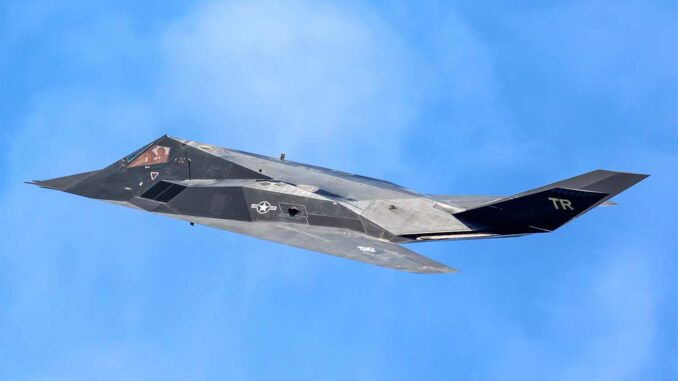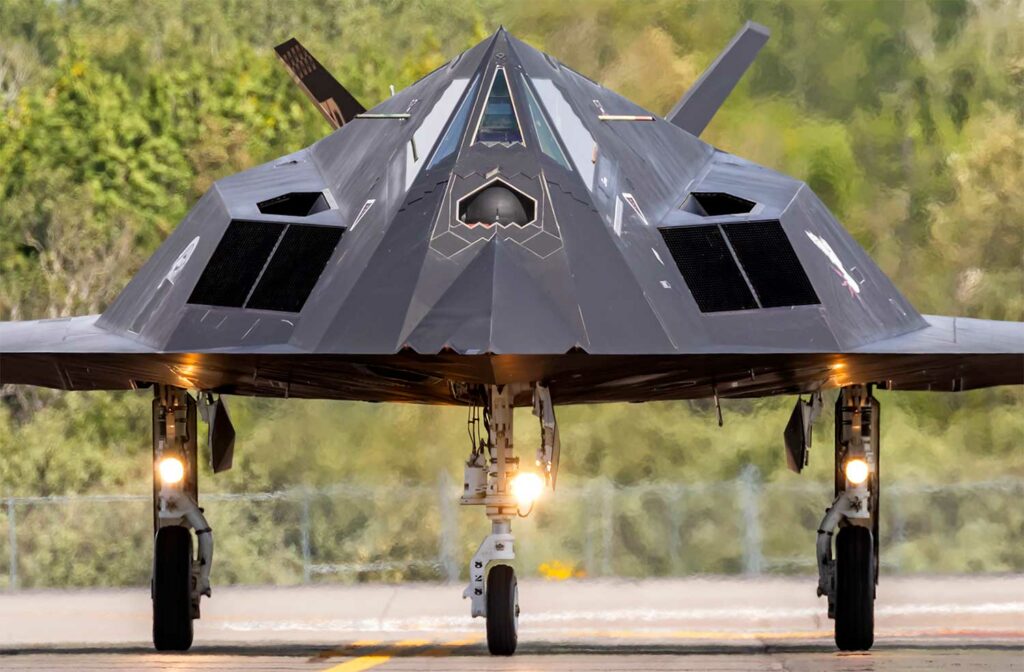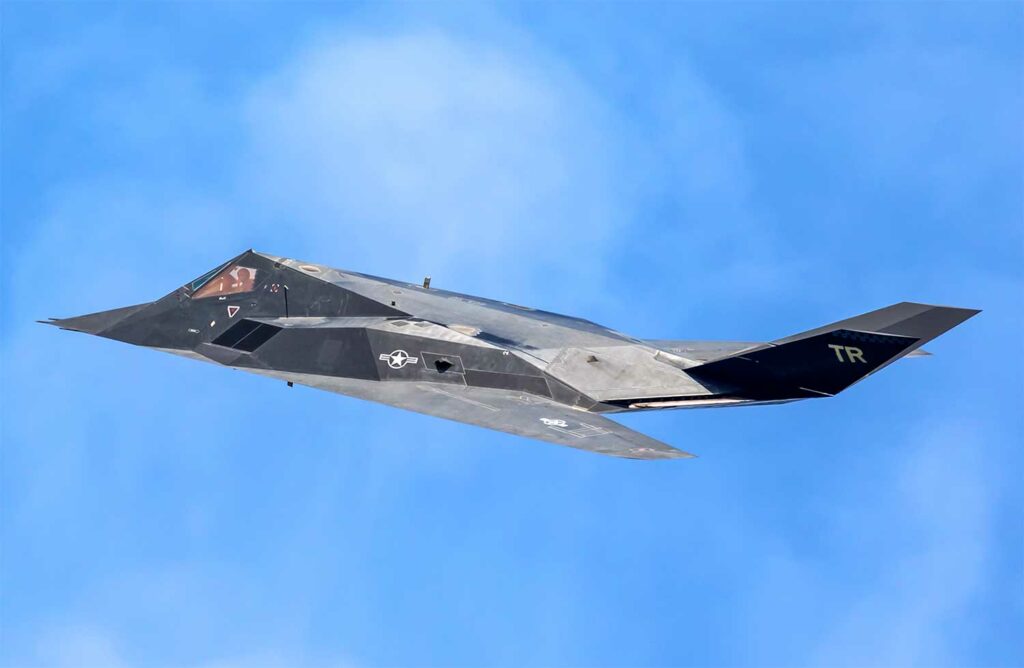
The Lockheed F-117 Nighthawk flew in secret from 1981 to 1988, hidden by the US Air Force at Groom Lake. A look back at an opaque military program.
In the shadow of satellites and radar
The Lockheed F-117 Nighthawk remained out of sight of the public and potential adversaries for nearly a decade. Commissioned in 1983, it was not officially recognized until November 1988 by the Pentagon. During this period, its existence, test flights, production sites, and even its operational role were completely concealed. This concealment was not simply a strategic choice: it was a response to a technological breakthrough in the context of the Cold War, when the slightest leak could provoke an asymmetrical response.
The F-117’s test flights were carried out exclusively at night at Groom Lake, in the Nevada Test and Training Range, better known as Area 51. This isolated and classified military base, protected by air restrictions and complex radar systems, served as a testing ground for one of the most sensitive projects in American aviation history.
This nationwide cover-up operation involved not only the US Air Force, but also the CIA, the NSA, and the Department of Defense. Silence was maintained for seven years, despite regular flights, the construction of a fleet of 64 aircraft, and their deployment to secure facilities such as the Tonopah Test Range.

The Have Blue program: a technological origin derived from Soviet research
A breakthrough from a Soviet research article
The secret history of the F-117 actually began in 1976 with the Have Blue program, a technology demonstrator project developed by Lockheed Skunk Works. The program originated from a Soviet scientific document published in 1964 by Petr Ufimtsev, which described how to predict the reflection of radar waves on flat surfaces. This text, ignored in the USSR, was recovered, translated, and then exploited in the United States.
Lockheed applied these calculations to a polygonal structure composed of sharp edges and sloping surfaces, creating a craft whose radar reflection was reduced by several orders of magnitude. The Have Blue demonstrator flew in 1977, proving that stealth was achievable, provided that aerodynamics were sacrificed.
The resulting F-117 owed its flight stability solely to a fully computerized control system with four redundant channels. Without digital assistance, the aircraft was unstable and impossible to fly. Its piloting therefore relied on precision onboard electronics, which represented a major advance in the late 1970s.
Large-scale logistical and operational concealment
An aircraft invisible even to the government
The F-117 program, codenamed “Senior Trend”, was developed in complete isolation. Component production was spread across several civilian and military sites, with shipments made at night under escort, sometimes with unidentified cargo to bypass standard administrative checks.
The pilots selected were drawn from the most experienced fighter squadrons and then isolated from the rest of the military chain. The 4450th Tactical Group, assigned to Tonopah Test Range, was created specifically to operate the F-117s. For several years, this unit officially flew A-7 Corsair IIs in broad daylight, while the F-117s took off at night to carry out test and validation missions.
To avoid aerial or satellite observation, Nighthawk flights were timed to coincide with the orbits of Soviet satellites. Schedules were planned to avoid any coincidences. A timing error could have led to a major leak, which explains the strict compartmentalization that was put in place.

A public revelation forced by circumstances
Recognition in 1988 dictated by rumor
In November 1988, the US Department of Defense finally officially acknowledged the existence of the F-117, under growing pressure from internal leaks, unexplained sightings, and speculative reports in the trade press. But even after this acknowledgment, no complete images of the aircraft were released immediately. The first photograph of the aircraft was not published until April 21, 1990.
This delay was motivated by increased risks associated with flight operations and the need to allow training in daylight. Several incidents had nearly revealed the program: a crash in 1986 in the Nevada desert and civilian sightings of a strange aircraft approaching Tonopah.
The F-117’s entry into operational service was announced as a major strategic event, although the public was unaware for years that around 50 missions had already been carried out in real conditions, notably in Panama and the Persian Gulf.
An aircraft designed to strike without being detected
Specialized in deep penetration
The Nighthawk was designed to strike strategic targets behind enemy lines, evading anti-aircraft defenses. It carried two GBU-27 laser-guided bombs weighing 910 kg each in an internal bay. The aircraft was neither supersonic nor agile, with a maximum speed of 1,100 km/h and a ceiling of 13,700 meters. The absence of active radar and guns reflected a radical philosophy: better not to be seen than to defend yourself.
Composite materials, slanted edges, absorbent paint, and thermal management made the F-117 extremely discreet to X-band radars. According to declassified documents, its radar signature was equivalent to that of a large bird.
Its operational effectiveness was confirmed during the 1991 Gulf War, where it was used in the first wave to neutralize Iraqi command centers. No aircraft were hit during the conflict, reinforcing the program’s aura of invulnerability.

A well-kept secret, but only for a while
The F-117 did not escape detection indefinitely. In March 1999, one was shot down in Serbia by an SA-3 Goa missile fired using a modified radar system. This shot highlighted the limitations of the first generations of passive stealth, particularly against adversaries capable of combining radar and low-frequency visual information.
Today, even though the program officially ended in 2008, several units continue to fly discreetly in Nevada for testing. Documents indicate that some F-117s are now used to train pilots to intercept stealth targets.
War Wings Daily is an independant magazine.